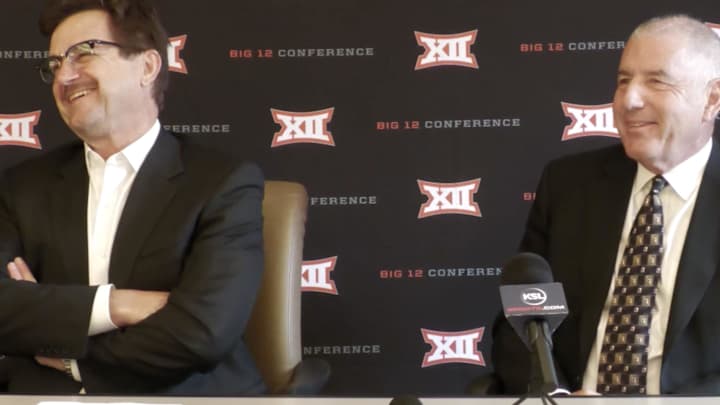What's Behind the Big 12's Record Distribution of $426 Million; What's Next for the League

IRVING, TX — The Big 12 Conference will distribute a record $426 million to its 10 member institutions this year, an average of about $42.6 million per school.
“I think we’ll continue to break records for the next two years,” said outgoing commissioner Bob Bowlsby.
Bowlsby even projects that the league will distribute another $50 million in total revenue — about $5 million per school — over the next two years with Oklahoma and Texas as members on their way to the Southeastern Conference in 2025.
Bowlsby and Lawrence Schovanec, chairman of the Big 12 board of directors, gave a 30-minute press conference Friday morning on the third and final day of the annual Big 12 spring business meetings at the Four Seasons Resort and Club, and each projected positivity for the league both in the short term and the long term.
This year’s revenue distribution is an increase of about 20 percent over last year, Bowlsby said, and is up about 9 percent from the 2019-20 pre-pandemic dollars.
When BYU, Central Florida, Cincinnati and Houston arrive — currently projected for the 2023 football season — they’ll receive Big 12 revenue on a graduated incremental basis. When the Big 12 added TCU and West Virginia, those schools received a 50 percent revenue share in 2012-13, 67 percent in 2013-14, 85 percent in 2014-15 and 100 percent in 2015-16. Bowlsby said when the three American Athletic Conference schools make it official, he expects a similar graduated scale.
Even 50 percent of more than $40 million is a massive increase for the three AAC schools, who reportedly received $7.96 million (UCF), $8.52 million (Houston) and $9.44 million (Cincinnati) last year, according to the Orlando Sentinel. BYU, independent of conference affiliation, got about $39 million in athletic revenue last year from its own TV deals and NCAA championships revenue, according to the U.S. Department of Education.
Bowlsby indicated this year’s revenue is a pleasant surprise coming off the 2020 pandemic.
”We clearly had some bumps in there,” Bowlsby said. “ … But we didn’t take as big a hit as it looked like we could have when we were sitting in August of 2020 and not knowing if we were even gonna play football. So we came through it better than we could have, that’s for sure.”
College sports has its problems. There’s talk of football splitting from the NCAA umbrella. NIL is seen a scourge by some. The transfer portal has offered opportunity, but also conceals countless caveats. But when it comes to the almighty dollar, big-time college sports appears to be business as usual.
“The impact on institutions varies even within our league,” Bowlsby said. “Our conference is no different than any other. We distribute $40 million this year to our members; for some that’s something approaching 50 percent of their annual budget. For others, that’s closer to 25 percent of their budget. So it varies from place to place as to the impact of it. It’s very important under any circumstances, and it’s a lot of money. We’re talking about $425 million.”
Other agenda items the league’s presidents and chancellors addressed on Friday:
- The Big 12 women’s basketball tournament in Kansas City will move next year (2023-24) from Municipal Auditorium to T-Mobile Center and will be staged the week before the men’s tournament.
- Contracts for both tournaments have been extended with Kansas City an additional two years through 2027.
- The Big 12 golf championships were the last sport without a television partner; starting next year the event will be carried by ESPN+.
Schovanec said "the financial aspect of this is very important" and would be in the future, which is admittedly cloudy.
"The manner in which we distribute this money is going to change," Schovanec said. "We’re all analyzing … with our new media partners. That will be one of the priorities of the new commissioner once that person is in place."
Schovanec said Friday's marketing and branding presentations revealed a bright future for the Big 12.
"There was a survey of those who watch and engage (in) sports," he said. "There is a slight dip in the perception of the league. We think that’s going to be very temporary. But our new conference is very strong in the 18-44-year-old bracket. We think that bodes very well for the future. … That presentation was very exciting to the board members. Very encouraging."

John is an award-winning journalist whose work spans five decades in Oklahoma, with multiple state, regional and national awards as a sportswriter at various newspapers. During his newspaper career, John covered the Dallas Cowboys, the Kansas City Chiefs, the Oklahoma Sooners, the Oklahoma State Cowboys, the Arkansas Razorbacks and much more. In 2016, John changed careers, migrating into radio and launching a YouTube channel, and has built a successful independent media company, DanCam Media. From there, John has written under the banners of Sporting News, Sports Illustrated, Fan Nation and a handful of local and national magazines while hosting daily sports talk radio shows in Oklahoma City, Tulsa and statewide. John has also spoken on Capitol Hill in Oklahoma City in a successful effort to put more certified athletic trainers in Oklahoma public high schools. Among the dozens of awards he has won, John most cherishes his national "Beat Writer of the Year" from the Associated Press Sports Editors, Oklahoma's "Best Sports Column" from the Society of Professional Journalists, and Two "Excellence in Sports Medicine Reporting" Awards from the National Athletic Trainers Association. John holds a bachelor's degree in Mass Communications from East Central University in Ada, OK. Born and raised in North Pole, Alaska, John played football and wrote for the school paper at Ada High School in Ada, OK. He enjoys books, movies and travel, and lives in Broken Arrow, OK, with his wife and two kids.
Follow johnehoover